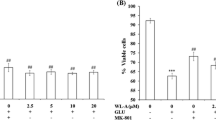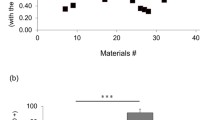Abstract
Curcumin, an extract from the plant Curcuma longa with well-known antioxidant and anti-inflammatory activities, was tested as protective agent against excitotoxicity in rat retinal cultures. A 24 h-treatment with curcumin reduced N-methyl-D-aspartate (NMDA)-mediated excitotoxic cell damage, estimated as decrease of cell viability and increase in apoptosis. The protection was associated with decrease of NMDA receptor-mediated Ca2+ rise and reduction in the level of phosphorylated NR1 subunit of the NMDA receptor. These results enlighten a new pharmacological action of the plant extract, possibly mediated by a modulation of NMDA receptor activity.




Similar content being viewed by others
References
Abe Y, Hashimoto S, Horie T (1999) Curcumin inhibition of inflammatory cytokine production by human peripheral blood monocytes and alveolar macrophages. Pharmacol Res 39:41–47
Aggarwal BB, Kumar A, Bharti AC (2003) Anticancer potential of curcumin: preclinical and clinical studies. Anticancer Res 23:363–398
Ambegaokar SS, Wu L, Alamshahi K, Lau J, Jazayeri L, Chan S, Khanna P, Hsieh E, Timiras PS (2003) Curcumin inhibits dose-dependently and time-dependently neuroglial cell proliferation and growth. Neuro Endocrinol Lett 24:469–473
Arundine M, Tymianski M (2003) Molecular mechanisms of calcium-dependent neurodegeneration in excitotoxicity. Cell Calcium 34:325–337
Bickler PE, Fahlman CS, Ferriero DM (2004) Hypoxia increases calcium flux through cortical neuron glutamate receptors via protein kinase C. J Neurochem 88:878–884
Chen RW, Qin ZH, Ren M, Kanai H, Chalecka-Franaszek E, Leeds P, Chuang DM (2003) Regulation of c-Jun N-terminal kinase, p38 kinase and AP-1 DNA binding in cultured brain neurons: roles in glutamate excitotoxicity and lithium neuroprotection. J Neurochem 84:566–575
Chen N, Li B, Murphy TH, Raymond LA (2004) Site within N-methyl-D-aspartate receptor pore modulates channel gating. Mol Pharmacol 65:157–164
Choi DW (1988) Glutamate neurotoxicity and diseases of the nervous system. Neuron 1:623–634
Choi DW (1992) Excitotoxic cell death. J Neurobiol 23:1261–1276
Chojnacka-Wojcik E, Klodzinska A, Pilc A (2001) Glutamate receptor ligands as anxiolytics. Curr Opin Investig Drug 2:1112–1119
Coyle JT, Tsai G, Goff DC (2002) Ionotropic glutamate receptors as therapeutic targets in schizophrenia. Curr Drug Target CNS Neurol Disord 1:183–189
Das KC, Das CK (2002) Curcumin (diferuloylmethane), a singlet oxygen ((1)O(2)) quencher. Biochem Biophys Res Commun 295:62–66
Duarte CB, Ferreira IL, Santos PF, Carvalho AL, Agostinho PM, Carvalho AP (1998) Glutamate in life and death of retinal amacrine cells. Gen Pharmacol 30:289–295
Frautschy SA, Hu W, Kim P, Miller SA, Chu T, Harris-White ME, Cole GM (2001) Phenolic anti-inflammatory antioxidant reversal of Abeta-induced cognitive deficits and neuropathology. Neurobiol Aging 22:993–1005
Ganguli M, Chandra V, Kamboh MI, Johnston JM, Dodge HH, Thelma BK, Juyal RC, Pandav R, Belle SH, DeKosky ST (2000) Apolipoprotein E polymorphism and Alzheimer disease: the Indo-US Cross-National Dementia Study. Arch Neurol 57:824–830
Ghoneim AI, Abdel-Naim AB, Khalifa AE, El-Denshary ES (2002) Protective effects of curcumin against ischaemia/reperfusion insult in rat forebrain. Pharmacol Res 46:273–279
Greengard P, Jen J, Nairn AC, Stevens CF (1991) Enhancement of the glutamate response by cAMP-dependent protein kinase in hippocampal neurons. Science 253:1135–1138
Hardingham GE, Bading H (2003) The Yin and Yang of NMDA receptor signalling. Trends Neurosci 26:81–89
Honjo M, Tanihara H, Kido N, Inatani M, Okazaki K, Honda Y (2000) Expression of ciliary neurotrophic factor activated by retinal Muller cells in eyes with NMDA- and kainic acid-induced neuronal death. Invest Ophthalmol Vis Sci 41:552–560
Krebs C, Fernandes HB, Sheldon C, Raymond LA, Baimbridge KG (2003) Functional NMDA receptor subtype 2B is expressed in astrocytes after ischemia in vivo and anoxia in vitro. J Neurosci 23:3364–3372
Lim GP, Chu T, Yang F, Beech W, Frautschy SA, Cole GM (2001) The curry spice curcumin reduces oxidative damage and amyloid pathology in an Alzheimer transgenic mouse. J Neurosci 21:8370–8377
Lipton SA, Rosenberg PA (1994) Excitatory amino acids as a final common pathway for neurologic disorders. N Engl J Med 330:613–621
Lopez T, Lopez-Colome AM, Ortega A (1997) NMDA receptors in cultured radial glia. FEBS Lett 405:245–248
MacDermott AB, Mayer ML, Westbrook GL, Smith SJ, Barker JL (1986) NMDA-receptor activation increases cytoplasmic calcium concentration in cultured spinal cord neurones. Nature 321:519–522
Malchiodi-Albedi F, Feher J, Caiazza S, Formisano G, Perilli R, Falchi M, Petrucci TC, Scorcia G, Tombran-Tink J (1998) PEDF (pigment epithelium-derived factor) promotes increase and maturation of pigment granules in pigment epithelial cells in neonatal albino rat retinal cultures. Int J Dev Neurosci 16:423–432
Meldrum B, Garthwaite J (1990) Excitatory amino acid neurotoxicity and neurodegenerative disease. Trends Pharmacol Sci 11:379–387
Ng YK, Zeng XX, Ling EA (2004) Expression of glutamate receptors and calcium-binding proteins in the retina of streptozotocin-induced diabetic rats. Brain Res 1018:66–72
Nicole O, Ali C, Docagne F, Plawinski L, MacKenzie ET, Vivien D, Buisson A (2001) Neuroprotection mediated by glial cell line-derived neurotrophic factor: involvement of a reduction of NMDA-induced calcium influx by the mitogen-activated protein kinase pathway. J Neurosci 21:3024–3033
Orrenius S, Zhivotovsky B, Nicotera P (2003) Regulation of cell death: the calcium-apoptosis link. Nat Rev Mol Cell Biol 4:552–565
Sreejayan N, Rao MN (1996) Free radical scavenging activity of curcuminoids. Arzneimittelforschung 46:169–171
Swope SL, Moss SJ, Raymond LA, Huganir RL (1999) Regulation of ligand-gated ion channels by protein phosphorylation. Adv Second Messenger Phosphoprotein Res 33:49–78
Wax MB, Tezel G (2002) Neurobiology of glaucomatous optic neuropathy: diverse cellular events in neurodegeneration and neuroprotection. Mol Neurobiol 26:45–55
Westphal RS, Tavalin SJ, Lin JW, Alto NM, Fraser ID, Langeberg LK, Sheng M, Scott JD (1999) Regulation of NMDA receptors by an associated phosphatase-kinase signaling complex. Science 285:93–96
Zhao BL, Li XJ, He RG, Cheng SJ, Xin WJ (1989) Scavenging effect of extracts of green tea and natural antioxidants on active oxygen radicals. Cell Biophys 14:175–185
Acknowledgements
The authors wish to thank Anna Maria M. Di Stasi for helpful comments and Lamberto Camilli for skilful photographic assistance. This work was partially funded by the Italian Ministry of Health (1% ricerca corrente 2002).
Author information
Authors and Affiliations
Corresponding author
Rights and permissions
About this article
Cite this article
Matteucci, A., Frank, C., Domenici, M.R. et al. Curcumin treatment protects rat retinal neurons against excitotoxicity: effect on N-methyl-D-aspartate-induced intracellular Ca2+ increase. Exp Brain Res 167, 641–648 (2005). https://doi.org/10.1007/s00221-005-0068-0
Received:
Accepted:
Published:
Issue Date:
DOI: https://doi.org/10.1007/s00221-005-0068-0




